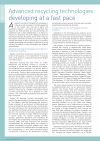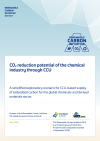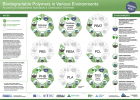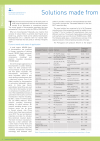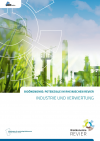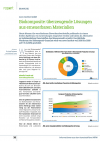Showing 61–80 of 127
-
Identified Advanced Recycling technology providers worldwide and maximum capacity (PNG)
Technology
1 Page
336 Downloads
336 Downloads
2022-06
FREE
Free Shipping336
DownloadsOverview about identified advanced recycling technology providers (blue bars) and maximum capacity (orange lines) depending on the technology.
-
875 Downloads
2022-06
FREE
Free Shipping875
DownloadsLife of a polymer from the production to its disposal (e.g. landfill) indicated with black arrows including various recycling and recovery routes indicated in different coloured arrows.
-
548 Downloads
2022-06
FREE
548
DownloadsAdvanced recycling technologies are developing at a fast pace, with new players constantly appearing on the market, from start-ups to giants and everything in between – new plants are being built, new capacities are being achieved, and new partnerships are established. Due to these developments, it is difficult to keep track of everything. The report “Mapping of advanced recycling technologies for plastics waste” aims to clear up this jungle of information providing a structured, in-depth overview and insight. It has an exclusive focus on profiling available technologies and providers of advanced recycling including the addition of new technologies and updated/revised profiles.
-
Renewable Materials Conference, 10-12 May 2022 (Proceedings)
Markets & Economy, Policy, Sustainability & Health, Technology
250 Downloads
250 Downloads
2022-05
FREE
Plus 19% MwSt.250
DownloadsThe proceedings of the Renewable Materials Conference (10-12 May 2022, https://renewable-materials.eu) contain conference presentations, the conference journal, and the press release of the three winners of the innovation award “Renewable Material of the Year”!
-
RCI’s scientific background report: “CO2 reduction potential of the chemical industry through CCU” (May 2022)
Sustainability & Health, Technology
28 Pages
1921 Downloads
1921 Downloads
2022-05
FREE
1921
DownloadsIn an exploratory scenario, this study investigates the CO₂ emission reductions that can be achieved in the global chemical and derived material industries if the entire demand for embedded carbon is met solely and exclusively via CO₂ instead of from fossil sources. Major simplifications are used to achieve transparency and comprehensibility of the issue. Methanol (CH3OH) is considered to cover the needs for hydrocarbons for chemicals and derived materials among the various chemical intermediates as a representative pathway for renewable carbon. It is a plausible scenario to assign methanol a central role in supplying the chemical industry of the future.
The GHG emissions of CCU-based methanol could be 67 to 77 % lower compared to emissions from releasing embedded carbon of fossil fuels, when using current energy supply based on photovoltaics. With improvements in renewable energy production, the reduction could increase to levels between 96 and 100 %.
DOI No.: https://doi.org/10.52548/UTRL5869
-
CCU-based Resource Supply for the Chemical Industry (PNG)
Sustainability & Health, Technology
1 Page
245 Downloads
245 Downloads
2022-05
FREE
245
DownloadsIt is a plausible scenario to assign methanol (CH₃OH) a central role in supplying the chemical industry of the future. Already today, methanol plays an important role in the chemical industry, being one of the most established commodities.
CCU-based process route for production of methanol includes production of hydrogen via electrolysis, CO₂ capture from the atmosphere or from industrial point sources, and the hydrogenation reaction. Electricity demand for these processes is represented by red arrows. Above the arrow, the specific energy demand is stated, below, the contribution of the process to the total electricity demand of 1 t of methanol is stated. Purification and compression of hydrogen are neglected. For CO₂ hydrogenation, a complete reaction is assumed.
-
CO₂ Emissions From Embedded Carbon in Chemicals (PNG)
Sustainability & Health, Technology
1 Page
290 Downloads
290 Downloads
2022-05
FREE
290
DownloadsWhen fossil feedstock is used, the fossil-based embedded carbon contained in chemicals and materials is emitted to the atmosphere at their end of life, assuming complete oxidation (e.g. through combustion or (bio)degradation).
When using CCU-based feedstock to replace the fossil feedstock, at the end of life, no additional carbon (or CO2, respectively) is emitted to the air because it was captured from the air (or from point sources) before through carbon capture. Only the electricity demand for CCU-based feedstock production causes CO2 emissions.
-
Emission Reduction Potential for Replacing Fossil Feedstock with CCU-based Methanol (PNG)
Sustainability & Health, Technology
1 Page
192 Downloads
192 Downloads
2022-05
FREE
192
DownloadsAt end of life, carbon embedded in chemicals and derived materials is released to the atmosphere as CO₂. In the case of fossil-based feedstock, this contributes to global warming. For CCU-based feedstock this is not the case, since all carbon embedded in these products was captured from the air (or from point sources) before through carbon capture. In a simplified model, additional emissions only electricity production for causes emissions for CCU-based feedstock production. Only the use of renewable energy can save emissions.
The GHG emissions of CCU-based methanol could be 67 to 77 % lower compared to emissions from releasing embedded carbon of fossil fuels, when using current energy supply based on photovoltaics. With improvements in renewable energy production, the reduction could increase to levels between 96 and 100 %. -
Conference on CO2-based Fuels and Chemicals 2022 Proceedings
Markets & Economy, Policy, Sustainability & Health, Technology
100 Downloads
100 Downloads
2022-04
FREE
Plus 19% MwSt.100
DownloadsThe proceedings of the Conference on CO2-based Fuels and Chemicals 2022 (23-24 March 2022, https://co2-chemistry.eu) contain 26 presentations, the conference journal, and the press release of the three winners of the Innovation Award “Best CO2 Utilisation 2022“.
-
International Conference on Cellulose Fibres 2022 Proceedings
Markets & Economy, Policy, Sustainability & Health, Technology
164 Downloads
164 Downloads
2022-02
FREE
Plus 19% MwSt.164
DownloadsThe proceedings of the International Conference on Cellulose Fibres 2022 (2-3 February 2022, https://cellulose-fibres.eu) contain 26 presentations, the conference journal, and the press release of the three winners of the Cellulose Fibre Innovation of the Year 2021 Award!
-
Biodegradable Polymers in Various Environments According to Established Standards and Certification Schemes – Graphic (PDF, Version 2021)
Sustainability & Health, Technology
1 Page
3267 Downloads
3267 Downloads
2021-11
FREE
3267
DownloadsNew updated version of the poster on Biodegradable Polymers in Various Environments According to Established Standards and Certification Schemes
The popular poster has been once again updated this autumn to depict to most up-to-date status of commercially available polymers which actually biodegrade in accordance with established standards and certification schemes. An additional partner rounds up this team of leading experts in the area of biodegradable polymers.
-
827 Downloads
2021-11
FREE
827
DownloadsToday, the various biocomposites can be easily used in a wide range of applications and have reached the mass market as an alternative to conventional plastics. The annual growth of biocomposite granulates has been estimated be 5 % by nova-Institut for 2020 to 2028 (CAGR). What are biocomposites? Basically, any material that consists of natural fibres or particles and a binder (e.g., polymer, resin) can be called a biocomposite. Biocomposites are a collective term for natural fibre-reinforced materials that are partly or entirely of biogenic origin. The report shows a full list of all biocomposite granulate producers in Europe.
-
Biodegradable Polymers in Various Environments According to Established Standards and Certification Schemes – Graphic (PNG, Version 2021)
Sustainability & Health, Technology
1 Page
1891 Downloads
1891 Downloads
2021-11
FREE
Free Shipping1891
DownloadsNew updated version of the poster on Biodegradable Polymers in Various Environments According to Established Standards and Certification Schemes
The popular poster has been once again updated this autumn to depict to most up-to-date status of commercially available polymers which actually biodegrade in accordance with established standards and certification schemes. An additional partner rounds up this team of leading experts in the area of biodegradable polymers.
-
Bioökonomie-Potenziale im Rheinischen Revier – Relevanteste Industriesektoren (JPG)
Markets & Economy, Technology
1 Page
30 Downloads
30 Downloads
2021-11
FREE
30
Downloads -
Studie Bioökonomie: Potenziale im Rheinischen Revier – Industrie und Verwertung (PDF)
Markets & Economy, Technology
76 Pages
113 Downloads
113 Downloads
2021-11
FREE
113
DownloadsEine Transformation der Wirtschaftsweise mit nachhaltigen, biobasierten Methoden eröffnet der Industrie einmalige Chancen für den Strukturwandel im Rheinischen Revier. Doch wie genau sehen die Beschäftigungseffekte, Umsätze sowie die Relevanz regionaler Industrie-Sektoren für eine biobasierte Wertschöpfung im Einzelnen aus?
Das nova-Institut hat im Auftrag der Strukturwandelinitiative BioökonomieREVIER hierzu eine Studie vorgelegt. Sie beleuchtet qualitative und quantitative Potenziale der Industrien in der Region. Diese erste Bestandsaufnahme zeigt, dass die regionale Sektorenvielfalt förderlich sein wird für die Etablierung neuer, branchenübergreifender Wertschöpfungsketten.
-
Bioökonomie-Potenziale im Rheinischen Revier – Industriebeschäftige nach Sektor (JPG)
Markets & Economy, Technology
1 Page
49 Downloads
49 Downloads
2021-11
FREE
49
Downloads -
Bioökonomie-Potenziale im Rheinischen Revier – Industrie und Verwertung (JPG)
Markets & Economy, Technology
1 Page
32 Downloads
32 Downloads
2021-11
FREE
32
Downloads -
Scenario for the Plastic Industry 2050 (PNG)
Markets & Economy, Policy, Sustainability & Health, Technology
1 Page
1508 Downloads
1508 Downloads
2021-10
FREE
1508
DownloadsThe plastics industry of the future will be decoupled from petrochemicals and will meet its carbon needs primarily from recycling. This alone will not close the renewable carbon cycle. The unavoidable losses will then be closed by bio- and CO2-based polymers.
-
Global Carbon Demand for Chemicals and Derived Materials (PNG)
Markets & Economy, Policy, Sustainability & Health, Technology
1 Page
1343 Downloads
1343 Downloads
2021-10
FREE
1343
DownloadsGlobal Carbon Demand for Chemicals and Derived Materials in 2020 and Scenario for 2050 in million of embedded carbon.
-
Biokomposite: überzeugende Lösungen aus erneuerbaren Materialien
Markets & Economy, Technology
3 Pages
420 Downloads
420 Downloads
2021-09
FREE
420
DownloadsHeute können die verschiedenen Bioverbundwerkstoffe problemlos in einem breiten Spektrum von Anwendungen eingesetzt werden und haben als Alternative zu herkömmlichen Kunststoffen den Massenmarkt erreicht. Das jährliche Wachstum der Biokomposit-Granulate wird von nova-Institut von 2020 bis 2028 auf 5 % (CAGR) geschätzt. Der Bericht zeigt zudem die 20 führenden Produzenten von Biokompost-Granulaten in Europa.



